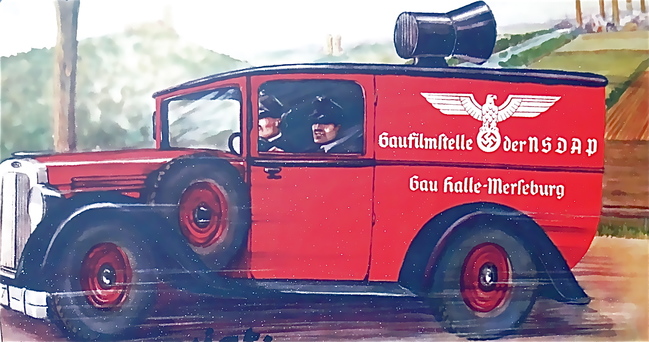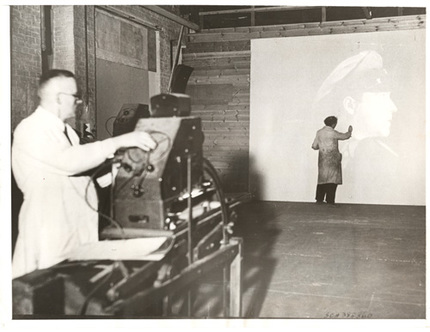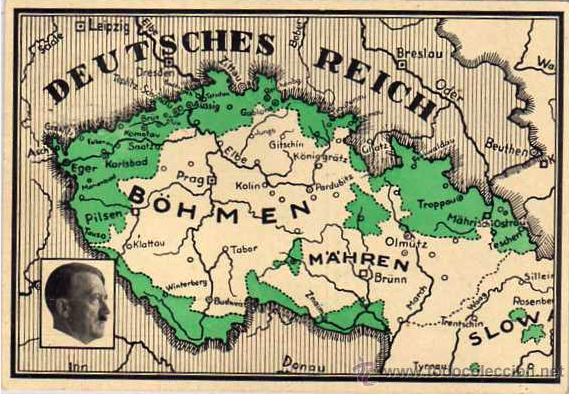
Information about the posters
All posters in the Collection are originals - no reproductions - and are very rare because the majority of these films were banned after WWII and in some cases are still taboo films today. All German posters have the Filmprüfstelle censor's stamp of approval printed on them. The Belgian and Italian posters have their national censor's 'postage stamps' intact.
Most German posters are the A0 "3 sheet" size (approx. 38 inches x 64 inches / 96.5 cm x 137 cm ). Smaller A1 German posters, such as GPU, DIESEL, DIE GROßE LIEBE, are approximately 23.3 inches x 33.1 inches / 59.4cm x 84.1 cm) in size, and the HITLERJUNGE QUEX Kleinplakat is A3 in size, or approximately 11.7 inches x 16.5 inches / 29.7 cm x 42 cm.
Non-Germany posters vary in size, basically in sizes A2, A1 and A0 (1-sheet, 2-sheet, and 3-sheet sizes). The largest French and Italian posters are a slightly larger format than the German A0 size (by about 3 inches in both length and width). The Belgian posters, other than the JUD SÜSS, are all A1 in size, and mostly printed on the back of previous posters because of paper shortages during the Occupation. The Belgian JUD SÜSS is A2 in size, or 16.5 inches x 23.3 inches / 42 cm x 59.4 cm ).
The largest non–Litfass posters in the Collection include the Italian OHM KRÜGER (with brown background) which is equivalent to two A0 sheets, printed in two halves, and the giant SCIPION L'AFRICAINE. The largest French posters, SUIS-JE UN ASSASSIN? (ICH KLAGE AN, 1941) and LES ADVENTURES FANTASTIQUES DU BARON MUNCHHAUSEN, are both 63 inches x 94 inches, equivalent to two side-by-side A0 "3 sheets" sheets printed in two halves.
BELOW, a press photo from March 1937 showing an image of popular actor Willy Fritsch being projected by an overhead projector onto a large white sheet on the wall. This image will be sketched by the graphic artist and used as the foundation of a painted colour image of the actor on an A0 large sized German film poster. This photograph is labeled "How the Germans make a movie poster." The photograph is from our Collection. The poster is for the film Menschen ohne Vaterland / Men without a Country, a propaganda film. You can see Fritzsch wearing the same cap and uniform in the "Illustrieter Film-Kurier" cinema programme shown below, RIGHT.


HOW TO FIND A PARTICULAR POSTER
The search engine for the Poster Gallery allows you to search for a particular film poster in various ways. You can enter the:
Film title
Film Director
Year of the Film's premiere
note: You can also search by Country, which will provide you the posters distributed in any country which presented German films during this time, either as an occupied land (such as France) or as an ally to Germany (such as Italy) or as a neutral country (such as Sweden.) Of course the Country shown means that is where that particular poster originated; not the film, which is always a German film; excepting the few Italian films with Italian language titles. In that case, for example, the Italian film ALCAZAR is listed as Italian when the original Italian poster is displayed, and the German poster for ALCAZAR is listed as "Germany" because the poster originated in Germany.

Special note: Czechoslovakia posters are those of the German films distributed when the nation of Czechoslovakia existed prior to the German take–over; and all German film posters during the German occupation are designated as those of the "Protektorat" (i.e. Böhmen & Mähren.) Our 2 original Riefenstahl OLYMPIA posters date from Czechoslovakia prior to the Munich Pakt.
note: To ENLARGE poster images, double click on their thumbnail !
In many cases, we have provided background information and images about the actual film, in which case this material is always placed ABOVE the poster on the poster page. So SCROLL DOWN TO THE BOTTOM OF THE POSTER PAGE TO VIEW THE ENLARGED IMAGE OF THE FILM POSTER.
All posters are part of a permanent collection and are not for sale. Very occasionally, second copies of some rare original posters surface and we offer them through our on–line Store.
Scholars may request non-watermarked TIFF and JPEG images of posters for legitimate publication use. All JPEGS/TIFFs on the website of movie posters are watermarked and have virtually invisible secondary markings on them which can prove that the images are from this website. Regrettably, it has become necessary to deface the images shown of some popular posters using a Photoshop type application to prevent the images from being used without permission on some commercial websites offering pirated copies of the films. The original posters do not have such markings on them.
The Collection has over 500 rare original German film posters from Germany, Italy, Spain, Occupied France and Belgium, and Scandinavia from this era. A few original posters of Italian fascist propaganda/military films, also in the Gillespie Collection, such as SCIPIONE L'AFRICANO, ALCAZAR, REDENZIONE, and I TRE AQUILOTTI, are also shown.


The two posters shown above for TITANIC (1943) as well the the poster for DER VERZAUBERTE TAG, were printed for cinema distribution with the official Filmprüfstelle censorship seal, but shortly after printing both feature films were banned from being shown within the Reich, and never were seen by German audiences until 1948-1951. These particular posters, then, are very rare as they have been printed and approved for distribution across Germany, but then never used. Only a handul of originals still exist.






